#their divine bow is also the most beautiful divine artifact btw at least imo lol
Explore tagged Tumblr posts
Text
Water Armatus, Bow and Arrow

I’ve always thought that it is interesting that the Water Armatus wields bow and arrow, especially since it holds many significances in the Japanese culture that Zestiria draws many inspirations from. I believe it’s a deliberate choice that the Divine Artifact needed for Water Armatus is a bow too, so I will try to elaborate more on this, since the many meanings for it might not be apparent to people who aren’t familiar with it.
Remember: Symbols can have more than just one meaning.
First off, and I know we start with the ending part here, but since it’s actually stated in the novel, I will talk about how Mikleo offers to go first, as the whistling arrow (嚆矢). Our first symbolism, but far from the last, for the Water Armatus.
「スレイ、最初に僕を撃ち出せ」
「ミクリオ…���!」
息を飲むスレイをミクリオは決意に満ち��瞳で見つめる。 最初に撃ち出す仲間を迷うであろうスレイの気持ちをくみ取った提案だった。
「この旅の終わり、僕が嚆矢となる」
僕たちの決意と覚悟を最初に撃て。
“Sorey, shoot me out first.”
“Mikleo...!”
Mikleo looks at Sorey, who gulped, intently with eyes full of his determination. It was a suggestion that took into consideration the feelings of Sorey, who had been hesitating about which friend he would shoot out first.
“At this journey’s end, I will become the whistling arrow.”
Shoot our determination and resolve first.
The whistling arrow (嚆矢) often symbolizes “dawn” or “beginning”, since it’s used to signal the beginning of battle. Particularly, around the time of Heian period, an arrow with a whistle (kabura, 鏑) attached (so often known as kabura-ya, 鏑矢 as well) would be shot, not only to alert the enemy, but also to ward off evil spirits and alert friendly kami to lend their support through its whistling sound. Befitting for the seraph whose Divine Artifact is a bow, since he does this to reassure Sorey, as well as to ask for support for him from the friendly kami—other seraphim that will come after him. Mikleo is also the one seraph who has been with Sorey since the beginning too, even before Sorey became the Shepherd. Since the dawn of the Shepherd (導師の夜明け).
(An arrow that flies straight and steadfast signifies no hesitation for its resolve.)

But bows and arrows mean so much more than this, so I would like to take a look at other meanings too, as well as going earlier than straight-up the final battle. The first obvious thing that stood out to me is that in Japanese, bow and arrow (弓矢, yumiya) is often a symbol for the battlefield, since 戦 (read as ikusa), meaning war or battle, used to be written as 射交矢 (also read as ikusa), roughly meaning exchanging arrows (射交わす矢). Hachiman (八幡神), the Shinto-Buddhism syncretic divinity of archery and war, is also known as Yumiya Hachiman (弓矢八幡), because his messenger is a dove that symbolizes bow and arrow. Hachiman’s wife, Himegami (比売神), often refers to Munakata Sanjoshin (宗像三女神), the three matriach kami associated with water born from the ukehi or oath (宇気比, 誓約) between Amaterasu and Susanoo (I will talk more about this when I talk about Mikleo’s association with water divinities in Japan, since it can get even more interesting if you dive deep and go down this rabbit hole, and I tend to overthink this kind of stuff anyway).
However, going back to a time even older, the ancient times, bow and arrow used to be written as 箭霊 (read as sachi), with 箭 being the outdated kanji for arrow and 霊 being the kanji for spirits, representing 霊威 or mysterious power. The word 箭霊 (sachi) here has the same reading as 幸 (sachi) meaning happiness, thus bow and arrow are also associated with happiness and blessings. As such, in Japan, where the animism of primitive religion remains strong, the bow and arrow is also a tool for divination of good fortune. In terms of shamanism/sorcery (呪術, jujutsu), often it is also called 天之返矢 (ama-no-kaeshiya, Divine Returning-Arrow), and this word comes from the myth in Kojiki, where a bird named Nakime (鳴女) who was sent down to earth to check in on Amewakahiko (天稚彦 or 天若日子). Amewakahiko shot the bird with his bow. The arrow pierced through the bird, but the arrow flew all the way to heaven. Takamimusubi (高御産巣日神) saw the arrow and threw it back at the earth where it hit Amewakahiko while he was laying in bed, killing him.
There are also Narugen (鳴弦), which is used like a weapon or musical instrument to exorcise invisible demons and evil spirits, and Hama-ya and Hama-yumi (破魔矢・破魔弓), symbols of the bow and arrow’s magical power, as seen in myths and legends.
Hama-ya, in general, has come to mean ceremonial arrow to ward off evil. In Buddhism, there is a legend that the gold bow and arrow held by Umarokya (烏摩勒伽), one of the four yaksha who follow Shoumen Kongou (青面金剛), the blue-faced Vajra, is the origin of the Hama-ya, and Ryuujin Hamaya (龍神破魔矢), the dragon deity, is named after it. The tip of hama-ya needs not to be sharp, since it is used to purify, as to remove the obstacles, not to target and break the person themself.
(I’d like to also remind that the seraphim are based upon Four Symbols, and Mikleo is based on the Azure Dragon. This can even be seen in the Water Armatus’ Banish Blast, 水神・清龍, which can literally be translated to Water Divine: Azure Dragon.)




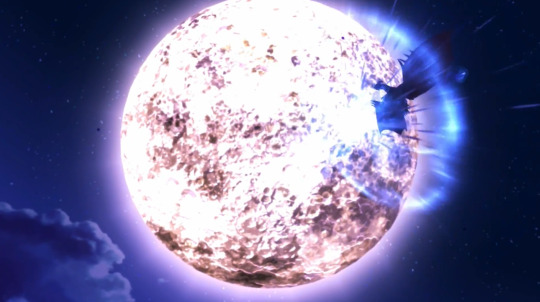
There is this one story, the tale of extermination of Nue (鵺)—a Japanese mythical creature with a monkey’s head, tanuki’s body, tiger’s limbs, and a snake tail—in “Heike Monogatari” (平家物語) where the Emperor was afflicted with an illness, but when Minamoto no Yoshiie (源義家) plucked the bowstring three times, the evil spirit was dispelled and the Emperor was restored to health. However, the source of the disease itself was not dead and continued to threaten the Emperor. Minamoto no Yorimasa (源頼政), then, climbed to the rooftop of the Imperial Palace at night and shot an arrow, and in just that one shot, slaying the source of the disease, a monster called Nue, with Yumiharidzuki (弓張月, representing the bow or the Moon, the crescent moon that looks like a bow).
And thus, the bow and arrow is associated with purification or exorcism (祓い清め) of the mind (心) from taint (穢れ), malice (邪気), evil (魔), and disaster (厄), as seen in a lot of metaphors in Japanese. The pure-hearted is said to be able to immediately hit the bull in one hit. The arrow of the noble is destined to strike the enemy and hunt the beast of fables.
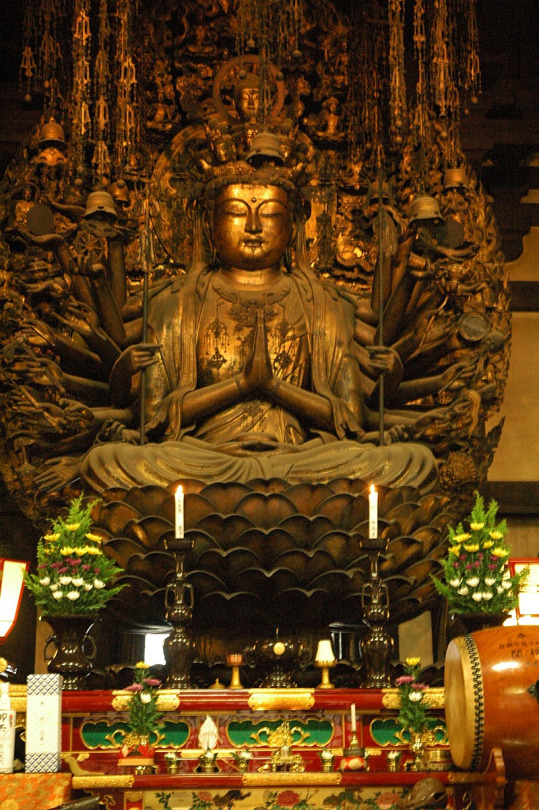
Now we turn to Buddhism. Senju Kannon (千手観音) or Senju-Sengen Kanzeon Bosatsu (千手千眼観世音菩薩), the bodhisattva of compassion and mercy, is perhaps the most widely worshipped bodhisattva in Japan. Senju-Sengen (千手千眼) literally means Thousand Arms and Thousand Eyes, originating from the fact that she has one eye in each palm of a thousand arms. These thousand arms and thousand eyes represent Kannon’s vastness of mercy and the abundance of means to save, as endeavors to relieve every living thing. In her many hands, she holds many objects, and each of these objects varies in meaning.
Two of them are houkyuu (宝弓) and houzen (宝箭), a bow and an arrow, respectively. Houkyuu stands for “increasing the honor” (“栄官を増す”), but more relevant is the meaning of houzen, which is “chance meeting with good friends” (“良き友に巡り会う”). A poetic way of saying reconnecting with true friends.


The final version of Aqua Limit, Aqua Limit: Ultima, is actually called アクアリムス・リユニオン, or Aqua Limit: Reunion, in Japanese. This indeed foreshadows their reunion in the epilogue, that they will meet again, and it is by chance (through a connection that ties them, that cannot be seen, yet can be felt, or it is precisely because it’s not seen that it can be felt stronger). Neither knew how long it would take, perhaps it would take centuries, but they could finally get there, reuniting with each other, in the end. Reunion of true friends. Mikleo, the bullet, the whistling arrow, is that connection with true friends that will never fade way, even as he is shot to the risk of his death in the final battle, and after this, Sorey will go to sleep to purify Maotelus for who knows how long. Eons, perhaps.
(Mikleo himself doesn’t consider himself as Sorey’s true friend, since he thinks that as a seraph, he can’t perceive the world the same way as Sorey does. It’s why he invited Rose to join the party. But true friends complement each other, just like how Sorey and Rose have different approaches [sees in different ways], Sorey and Mikleo complement each other through their differences.)
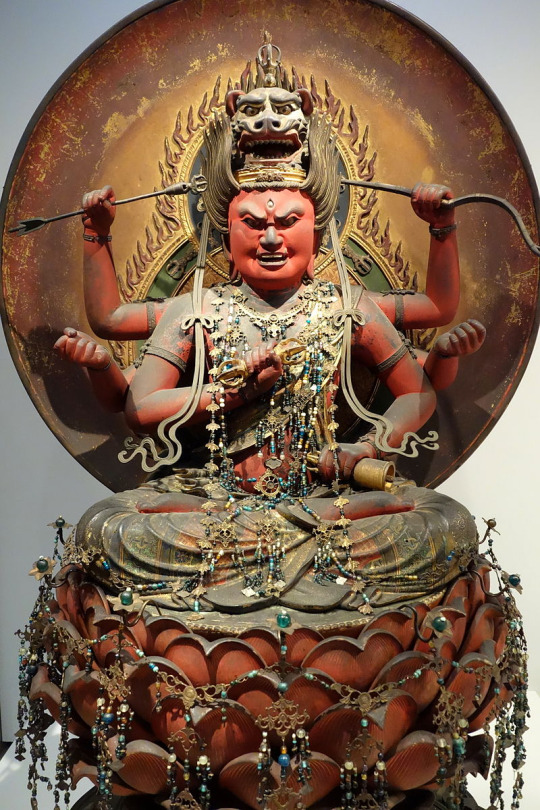
In Buddhism (especially Shingon Buddhism), there is a deity that is often associated with bow and arrow, Aizen Myouou (愛染明王). He has a very distinctive appearance, wearing a shishi (獅子, magical lion)’s crown on his head and sitting on a lotus flower. Sometimes, he is depicted with two heads: of his own and of Fudou Myouou (不動明王, and I believe I’ve talked about Sorey being a Fudou Myouou figure here), symbolizing a commingling of subjugated, complementary energies, and in Japan, they are both enshrined together, Fudou Myouou and Aizen Myouou on the left and right of Dainichi Nyorai (大日如来, I talked about him and his symbolism more in the context of Zestiria here) as the principal object of worship. In Nichiren Buddhism, in the Great Mandala Gohonzon, Fudou Myouou’s bīja “हां” is placed on the right and Aizen Myouou’s bija “हूं” is placed on the left (more on Sorey and Mikleo and Right and Left here and here and here, also while we’re at this, the Left, when paired with the Right, has significance in Shinto here, so there are many layers of meanings to this).

Aizen Myouou is known for transforming worldly desires (kleshas) into spiritual awakening, as seen from his name literally meaning “Love-Stained Wisdom King.” In Nichiren Buddhism, it is said that if Fudou Myouou embodies “life and death (saṃsāra) are precisely nirvana” (生死即涅槃, shouji-soku-nehan), then Aizen Myouou embodies “worldly desires (kleshas) are precisely enlightenment (bodhi)” (煩悩即菩提, bonnou-soku-bodai), which are the two tenets of hongaku (本覚, the innate or original enlightenment). This is because Aizen Myouou doesn’t deny love, and he is indeed known as the Buddha in charge of love, marriage, family harmony; of relationships and connections in general. His name, Aizen (愛染), can also be interpreted as the color(s) aizen (藍染).
I say uniquely Japanese, because the colors are indeed called Japanese blue; depending on how many dips, the shade changes--not just in value but also hue. The lighter it is, the closer it is to blue-green hue. The deeper it is, the closer it is to indigo blue hue.
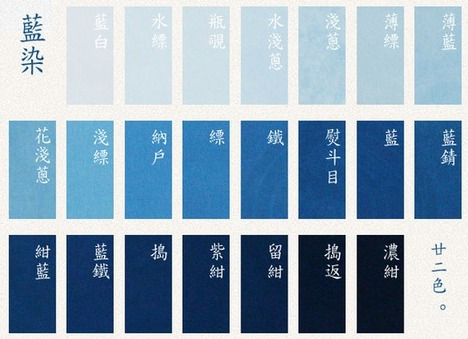
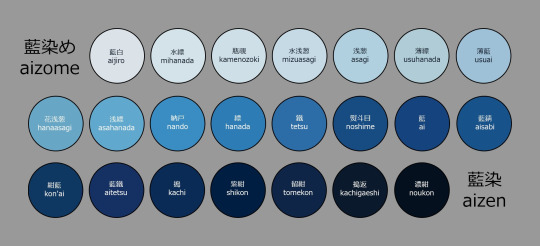
(I also must say that the lighter green-ish blue shade is called 水色 too. Literally the color of water. Commonly translated as aquamarine.)

Like the traditional Japanese blue shades, Sorey's blue is more on the deep indigo blue side in its hue and Mikleo's blue is more on the light aqua blue. Meanwhile, Water Armatus (the two of them) is the "balanced" blue in the middle.

(I have an entire Twitter thread too for this too here)
Finally, I want to talk about a certain saying that also originates from Nichiren Buddhism:

やのはしる事は弓のちから、くものゆくことは・りうのちから、をとこのしわざは・めのちからなり。
The original writing is rather hard to read because it’s written almost entirely in hiragana, but it can be transliterated as follows:
矢の走る事は弓の力、雲の行く事は竜の力、男の仕業は婦の力なり。
Which can be translated to:
It is the power of the bow that determines the flight of the arrow, the might of the dragon that controls the movement of the clouds, and the strength of the wife that guides the actions of a man.
(Remember, again, that Mikleo is connected to dragons/竜, that he is based on Azure Dragon/清龍, and clouds are connected to rain/water and thunder/lightning, two elements associated with Mikleo and Sorey respectively.)
This is from the letter of Nichiren Daishounin (日蓮大聖人). I hope the meaning is obvious enough even without my explanation.
The bow and arrow work in tandem. Without the bow, the arrow cannot work. Without the arrow, the bow cannot work either. It is in the relationship, that even a relationship between a husband and a wife is likened to this.

The same dialogue from the first Water Armatus battle above is repeated again in this scene:


MIKLEO: Sorey, I’ll do the aiming. SOREY: Right. And I’ll pick when to fire.
Despite the Armatization being literally a process of becoming one, of two different physical bodies becoming one, interestingly the human and seraph still retain each of their own consciousness. They don’t blend into one, and the workings of this can be seen in Sorey and Mikleo coordinating to handle the timing and aiming, respectively, when in Water Armatus. Armatus does work in mysterious ways, and it perhaps cannot be described in feelings known to common humans.
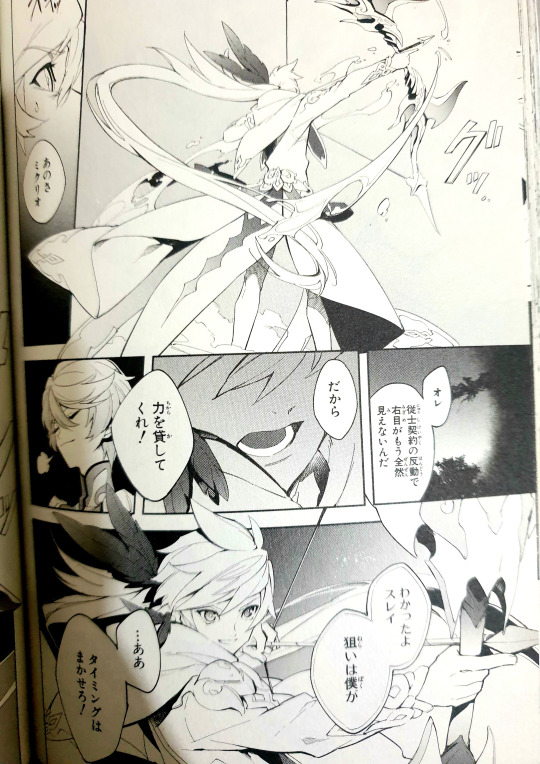
SOREY: By the way, Mikleo. SOREY: Because of the Squire pact, I can’t see out of my right eye anymore. SOREY: So... SOREY: Lend me your power! MIKLEO: Got it, Sorey. I’ll do the aiming. SOREY: Right. And I’ll pick when to fire!
The manga outright makes Mikleo act as Sorey’s eye when aiming at the target, while Sorey handles the timing because of this. This communion, tacit understanding is a major part of their bond, after all, even without the Armatization. The novel also makes it a point that Mikleo offers to do the aiming because he has realized for a long time already that Sorey is blind on his right eye.
異体同心 種族は違うが、同じ想いを抱いて育った。人と天族の可能性を示す。
One Heart in Different Bodies They are of different kinds, but they grew up embracing the same feelings. Showing the possibilities of humans and seraphim.
Exactly because they’re different that they can understand each other, can complement each other, as has been said before. I’ve talked about how Mikleo had needed to learn this, shortly, when I said he didn’t consider himself Sorey’s true friend, but even Sorey needed to learn about this.

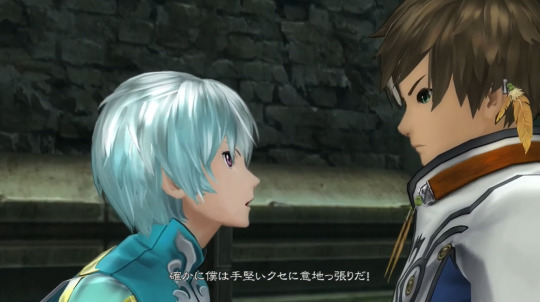




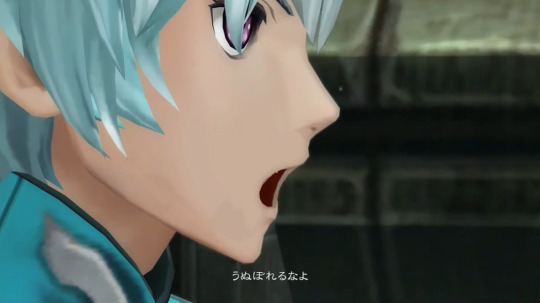

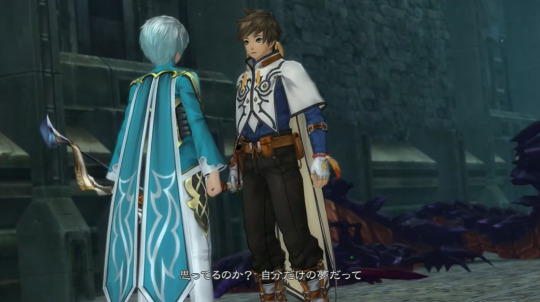



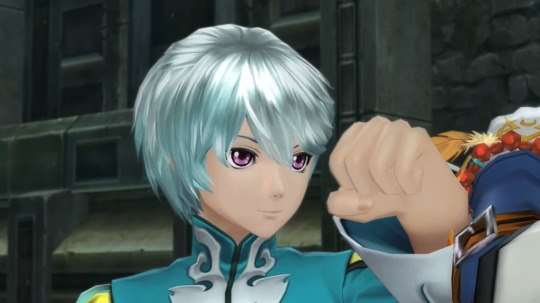
SOREY: Wait, hold on now! MIKLEO: You’re right, I am stubborn as a rock! SOREY: Huh? MIKLEO: I admit it. I’m hell-bent on becoming a Sub Lord. MIKLEO: But there’s something important that you don’t understand! SOREY: I do understand! I just didn’t want you to get involved! MIKLEO: Get over yourself. SOREY: ! MIKLEO: Do you really think this is your dream alone?
SOREY: This is our dream.
Sorey’s flaw in the beginning is that he tends to carry everything by himself, that he doesn’t want the people he cares about to be hurt because of him (or what he thinks as his own responsibility, and not anyone else’s). He was alright with sharing happiness, but afraid to share anything else, even though it was implied that Michael failed as a Shepherd because he carried that burden alone. Even when Sorey and Mikleo fought (because they cared too much about each other), this had already had an effect on Sorey: he didn’t feel the excitement of exploring ruins, he couldn’t see the Earthen Historia, he wasn’t able to de-Armatize at will; and it was only when he accepted Mikleo’s offer to help him, that he could do all these and more (like how Alisha was finally able to hear the seraphim’s voices.)

MIKLEO: I know because it’s you; you were thinking that you didn’t want me to be involved, or that you didn’t want me to carry the burden. MIKLEO: But it’s too late for all that. MIKLEO: Our journey began a long time ago already. MIKLEO: It’s not just your dream. SOREY: ...Yeah. SOREY: This is our dream!
A relationship is balanced if it’s two-way. Their bond is meant to show the limitless possibilities of how a human and seraph can work together to reach their dream together, the dream of coexistence, of being together. To be together is to share not just happiness but also sadness. It’s because life is not lived just by yourself alone, but also with others.

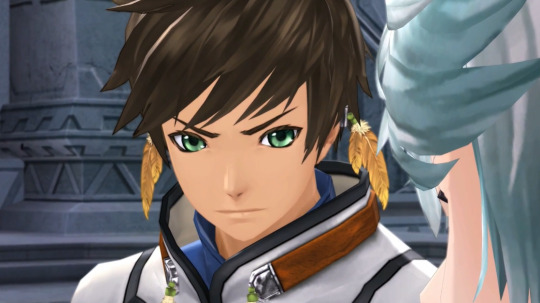
I won’t let you carry this by yourself.
Even until the very end. Just like the power of the bow determines the flight of the arrow, the arrow that flies straight and steadfast without any hesitation for its resolve, warding off anything that is evil, purifying the heart from taint, calling for friendly divinities to aid them. It will reunite them, the true friends, no matter the odds, just bet on that one chance. And this love is not to be denied.
You’ve matured through the course of this journey, and I’m proud of you for that, but don’t forget, I’m also here, right next to you, and I won’t let you carry everything by yourself.
唯一無二の 互いに誰よりも負けたくない相手。だから成長できる。今までも、これからも。
The One and Only They do not want to lose to each other more than anyone else. That’s why they can grow. Until now, and from now on.
Mikleo is the best support Sorey could’ve gotten, even if he didn’t ask for him himself.
May these bow and arrow represent happiness and blessings, just as they used to in the ancient times long past.
弓を構えて真実射抜け
Pull the bow and aim for the truth.
#tales of#tales of zestiria#mino talks zesty#mino rambles#yet another#srmk lovemail#their divine bow is also the most beautiful divine artifact btw at least imo lol#sorey really needed to unlearn his meebogynist views lol#i am now emotional again over all the water armatus moments in the game#i did this to myself and now you all have to experience it too with me
35 notes
·
View notes